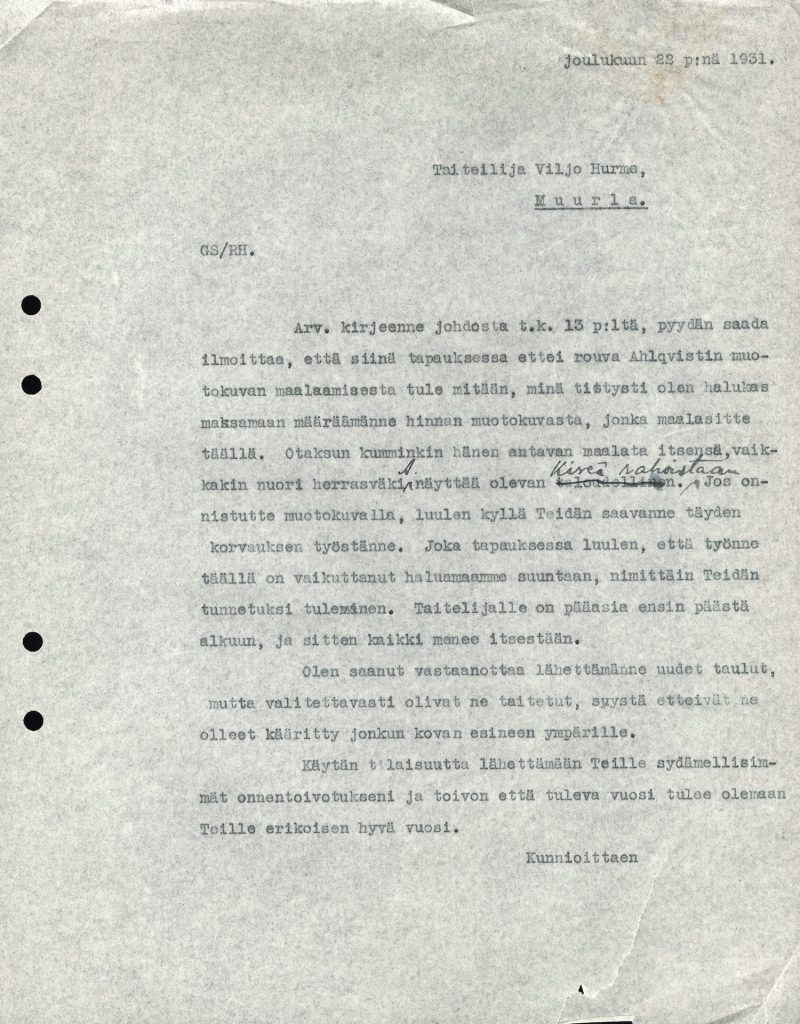Viljo Hurme: Plough
A work and depiction of a period from a hundred years ago
JULY 2024
Gösta Serlachius and artist Viljo Hurme exchanged letters in the early 1930s. In the light of their correspondence, it seems that Hurme was one of the artists with whom Serlachius planned to collaborate more closely.
Viljo Hurme (1893–1987) had studied at the Turku Drawing School in the 1910s. His subjects were depictions of work painted in watercolour, such as this work completed a hundred years ago. Since then, he also began to paint in oil, and his motifs also included portraits, which Serlachius encouraged him to paint.
Serlachius had seen two of Hurme’s works at Strindberg’s art salon in May 1931, and he had bought one of them. “… Judging by this painting, I would be happy to acquire more of your works. I therefore venture to ask whether it would be appropriate for you to come here to the country side (Huhkojärvi estate) during the summer and paint a few works according to your choice of subjects, which we could then negotiate in detail whether I could buy them.”
It was at the turn of the 1920s and 30s that Serlachius was building the Huhkojärvi estate in the landscapes where Akseli Gallen-Kallela had decades earlier created his best works from his younger years. He had commissioned sculptor Hannes Autere to design and build the Huhkojärvi milieu. The themes of Hurme’s works fit into the vernacular world of Autere’s works.
Serlachius wrote to the artist Hurme that “your work here has influenced the direction you wanted, namely your being known. For an artist, the main thing is to get started first, and then everything will go by itself.” He had said the same to Autere.
At Serlachius’ request, Hurme had given Serlachius his paintings for sale, and several of them were sold in a short time. Serlachius urged the artist to send his paintings to Strindberg’s art salon as well, “because Director Lydecken and I have decided to take you as our task”. Serlachius considered that “it is very important that we act to promote you while Strindberg exhibits your paintings in his shop window.” The public was interested in Hurme’s works, and Lydecken, the director of the art salon, had heard commendable statements about them.
Serlachius thought that if the artist also succeeded in painting portraits, “we would certainly enjoy a pleasant collaboration.” He had tried to “inspire” people to order portraits from Hurme, and many were interested in the matter. The Gösta Serlachius Fine Arts Foundation’s collection include a portrait of Ruth Serlachius from 1931 painted by Hurme. However, the portraits did not succeed in a desired way and the collaboration seemed to end.
Viljo Hurme’s artist career lasted almost 80 years. He continued to make art until the end of his life. In the 1960s his art found inspiration in the details of the landscape and his expression became more non-figurative. The artist donated more than 500 paintings to his foundation, established in 1982, which in turn deposited some of them in the Salo Art Museum. The artists’ home in Muurla was opened to the public in 1987.
Helena Hänninen
Curator




